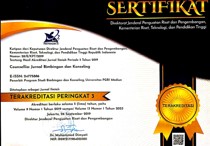Paradoxical intervention dalam bimbingan dan konseling untuk mengatasi kecemasan
Abstract
Abstrak
Kecemasan adalah perasaan tidak menentu yang membuat seseorang merasa takut dan khawatir. Kecemasan pada tingkat tertentu mampu membuat seseorang menjadi lebih produktif, sebaliknya, kecemasan berlebihan dapat merusak. Salah satu upaya yang dapat dilakukan untuk mengurangi kecemasan adalah pemberian layanan bimbingan dan konseling, terutama menggunakan paradoxical intervention yang telah terbukti efektif untuk mengatasi gangguan kecemasan. Melalui artikel ini penulis mencoba menyajikan satu teknik intervensi unik yang bisa menjadi alternatif bagi guru bimbingan dan konseling atau konselor untuk membantu konseli mengatasi kecemasan dan meningkatkan keefektifan layanan bimbingan dan konseling.
Kata Kunci : Kecemasan, Bimbingan dan Konseling, Paradoxical Intervention.
Abstract
Anxiety is an uncertain feeling that makes someone fear and worry. Anxiety in a certain level able to makes someone more productive, in opposite, excessive anxiety can be obstructive. An effort that can utilize to reduce anxiety is guidance and counseling, particularly, paradoxical intervention which evidence-based shown highly effective to overcome the anxiety disorder. Through this article author is trying to present an unique intervention technique which can be an alternative for guidance and counseling teacher or counselor in order to help counselee coping with anxiety and promoting the effectiveness of guidance and counseling service.
Keywords : Anxiety, Guidance and Counseling, Paradoxical Intervention.Keywords
Full Text:
PDFReferences
Alwisol. (2014). Psikologi Kepribadian (Revisi). Malang: UMM Press.
Ameli, M., & Dattilio, F. M. (2013). Enhancing cognitive behavior therapy with logotherapy: Techniques for clinical practice. Psychotherapy, 50(3), 387–391. https://doi.org/10.1037/a0033394
Ascher, L. M. (2005). Paradoxical intention and related techniques. Dalam Encyclopedia of Cognitive Behavior Therapy (hlm. 264–268). Springer.
Ascher, L. M., & Schotte, D. E. (1999). Paradoxical intention and recursive anxiety. Journal of Behavior Therapy and Experimental Psychiatry, 30(2), 71–79.
Barlow, D. H. (2002). Anxiety and Its Disorders The Nature and Treatment of Anxiety and Panic (2 ed.). New York: The Guilford Press.
Bucklew. (1980). Paradigm for Psychology: A Contribution to Case Hastory Analysis. New York: J. B. Lippen Cott Company.
Conoley, C. W., & Garber, R. A. (1985). Effects of Refraining And Self-Control Directives on Loneliness, Depression, and Controllability. Journal of Counseling Psychology, 32, 139–142.
Corey, G. (2012). Theory and Practice of Counseling and Psychotherapy (9 ed.). Canada: Brooks Cole.
Dattilio, F. M. (1987). The use of paradoxical intention in the treatment of panic attacks. Journal of Counseling & Development, 66(2), 102–103.
Domschke, K., Stevens, S., Pfleiderer, B., & Gerlach, A. L. (2010). Interoceptive sensitivity in anxiety and anxiety disorders: An overview and integration of neurobiological findings. Clinical Psychology Review, 30(1), 1–11. https://doi.org/10.1016/j.cpr.2009.08.008
Dunlap, K. A. (1928). Revision of the Fundamental Law of Habit Formation. Science, 67, 360–362.
Ellis, A., & Dryden, W. (1997). The Practice of Rational Emotive Behavior Therapy. New York: Springer Publishing Company.
Erford, B. T. (2014). 40 Tecniques Every Counselor Should Know (2 ed.). New Jersey: Pearson.
Feist, J., & Feist, G. J. (2006). Theories of Personality (6 ed.). New York: McGraw Hill.
Foreman, D. M. (1990). The Ethical Use of Paradoxical Interventions in Psychotherapy. Journal of Medical Ethics, 16, 200–205.
Frankl, V. E. (1986). Men’s Search for Meaning. New York: Washington Square Press.
Hill, K. A. (1987). Meta-analysis of paradoxical interventions. Psychotherapy: Theory, Research, Practice, Training, 24(2), 266.
Indonesia, M. P. dan K. R. (2014). Peraturan Menteri Pendidikan dan Kebudayaan Republik Indonesia Nomor 111 Tahun 2014. Jakarta. Diambil dari http://jdih.kemdikbud.go.id/new/public/assets/uploads/dokumen/permendikbud_tahun2014_nomor044.pdf
Kamaruzzaman, K. (2017). Analisis Faktor Penghambat Kinerja Guru Bimbingan dan Konseling Sekolah Menengah Atas. Sosial Horizon: Jurnal Pendidikan Sosial, 3(2), 229–242.
Kebudayaan, D. P. dan. (2007). Rambu-rambu Pelaksanaan Bimbingan dan Konseling pada Jalur Pendidikan Formal. Jakarta: Direktorat Jenderal PMPTK.
Kebudayaan, K. P. dan, & Kependidikan, D. J. G. dan T. (2016). Panduan Operasional Penyelenggaraan Bimbingan dan Konseling. Diambil dari http://unw.ac.id/site/download/kerjasama/815e6212def15fe76ed27cec7a393d59/Panduan_Penyelenggaraan_BK_SMK.pdf
Lanza, C., Müller, C., & Riepe, M. W. (2017). Positive mood on negative self-statements: paradoxical intervention in geriatric patients with major depressive disorder. Aging & Mental Health, 1–7. https://doi.org/10.1080/13607863.2017.1306834
Lopez, F. G., & Wambach, C. A. (1982). Effects of Paradoxical and Self-Control Directives in Counseling. Journal of Counseling Psychology, 29, 115–124.
March, M. C. (1997). Treatment Acceptability of Paradoxical Interventions: the Role of Dissonance. Lowa State University.
Michelson, L., & Ascher, L. M. (1984). Paradoxical intention in the treatment of agoraphobia and other anxiety disorders. Journal of behavior therapy and experimental psychiatry, 15(3), 215–220.
Muarifah, A. (2012). Hubungan kecemasan dan agresivitas. Humanitas (Jurnal Psikologi Indonesia), 2(2), 102–112.
Naragon-Gainey, K. (2010). Meta-analysis of the relations of anxiety sensitivity to the depressive and anxiety disorders. Psychological Bulletin, 136(1), 128–150. https://doi.org/10.1037/a0018055
Norcross, J. C. (2011). Psychotherapy Relationships that Work: Evidence-Based Responsiveness (2 ed.). New York: Oxford University Press.
Ott, B. D., Levine, B. A., & Ascher, L. M. (1983). Manipulating the explicit demand of paradoxical intention instructions. Behavioural and Cognitive Psychotherapy, 11(1), 25–35.
Salomon-Shoham, V., & Jancourt, A. (1985). Differential Effectiveness of Paradoxical Interventions for More Versus Less Stress-Prone Individuals. Journal of Counseling Psychology, 32, 449–453.
Salomon-Shoham, V., & Rosenthal, R. (1987). Paradoxical interventions: A meta-analysis. American Psychological Association.
Shi, X., Brinthaupt, T. M., & McCree, M. (2015). The relationship of self-talk frequency to communication apprehension and public speaking anxiety. Personality and Individual Differences, 75, 125–129. https://doi.org/10.1016/j.paid.2014.11.023
Supriadi, D. (2003). Reposisi Bimbingan Konseling di Tengah Lingkungan yang Berubah (hlm. 2–5). Dipresentasikan pada Konvensi Nasional BK 2003, Bandung.
Taylor, S., Zvolensky, M. J., Cox, B. J., Deacon, B., Heimberg, R. G., Ledley, D. R., … Cardenas, S. J. (2007). Robust dimensions of anxiety sensitivity: Development and initial validation of the Anxiety Sensitivity Index-3. Psychological Assessment, 19(2), 176–188. https://doi.org/10.1037/1040-3590.19.2.176
Wahyuni, E. (2015). Hubungan Self-Effecacy dan Keterampilan Komunikasi dengan Kecemasan Berbicara di Depan Umum. Jurnal Komunikasi Islam, 5(1), 51–82.
Watson, C. (1991). A Delphi Study of Paradox in Therapy. Dalam Promoting Change Trough Paradoxical Therapy (Revised). New York: Brunner/Mazel.
Article Metrics
Abstract has been read : 5066 timesPDF file viewed/downloaded: 0 times
DOI: http://doi.org/10.25273/counsellia.v7i2.1852
Refbacks
- There are currently no refbacks.
Counsellia is Indexed By:
Counsellia Office:
Universitas PGRI Madiun
Program Studi Bimbingan dan Konseling

This work is licensed under a Creative Commons Attribution-NonCommercial-ShareAlike 4.0 International License.














